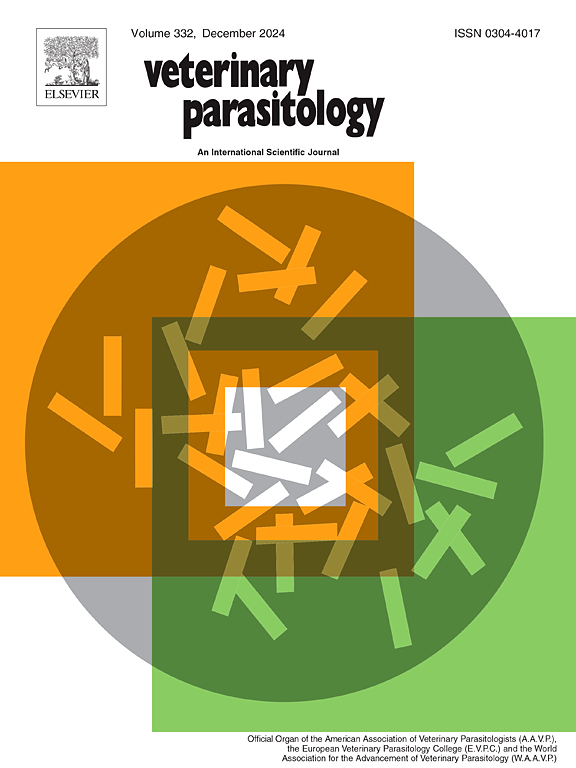Can the tick Rhipicephalus microplus transmit Trypanosoma vivax to cattle by the transovarial and mechanical routes?
IF 2.2
2区 农林科学
Q2 PARASITOLOGY
引用次数: 0
Abstract
Due to the presence of Trypanosoma vivax DNA in ticks, transovarian and mechanical transmission is suspected. The present study aimed to evaluate (i) the presence of T. vivax in R. microplus that fed on animals with acute trypanosomosis; (ii) the transovarian transmission; and (iii) the ability of larvae and males to mechanically transmit T. vivax to cattle in a region without a cyclic vector. To this end, six calves were experimentally infected with T. vivax on day 0, and after different intervals, these animals were infested with cattle tick larvae. Before oviposition, the content of engorged females was submitted to blood smear to detect trypomastigotes. After oviposition, the engorged females were tested for T. vivax DNA. To assess transovarian transmission, pools of egg masses and larvae from these females were also tested for T. vivax DNA. The larvae were then fed on three negative animals. In addition, to assess mechanical transmission, males from the infestation of animals with trypanosomosis were removed and placed on three other T. vivax-negative calves to feed for 25 days. The male ticks were also tested for T. vivax DNA. The six animals infected with T. vivax showed parasitemia 5–21 days post-infection, when they were treated with a trypanocide drug. Trypanosoma vivax trypomastigotes and DNA were detected in engorged females of R. microplus, but not in egg masses and larvae from engorged females that fed on calves positive for this protozoon. In males, no T. vivax DNA was detected after they fed on cattle positive for T. vivax, and no mechanical transmission was observed.
小鼻头蜱能否通过经卵巢和机械途径将间日锥虫传播给牛?
由于蜱虫中存在间日锥虫DNA,因此怀疑是经卵巢和机械传播。本研究旨在评价(1)以急性锥虫病动物为食的小褐蝽体内是否存在间日疟原虫;(ii)跨卵巢传播;(iii)在没有循环病媒的地区,幼虫和雄性机械地将间日疟传播给牛的能力。为此,在第0天实验感染了6头犊牛,并在不同的时间间隔后,对这些犊牛进行了牛蜱幼虫侵染。在产卵前,将充血的雌虫内容物进行血涂片检测锥乳线虫。产卵后,对肿胀的雌性进行间日疟原虫DNA检测。为了评估跨卵巢传播,还对这些雌性的卵团和幼虫进行了间日疟原虫DNA检测。然后用三只阴性动物喂养幼虫。此外,为了评估机械传播,从感染锥虫病的动物中取出雄性,并将其放在另外三只间日疟原虫阴性的小牛身上喂养25天。对雄性蜱虫也进行了间日疟原虫DNA检测。感染间日疟原虫的6只动物在感染后5-21 天出现寄生虫病,当时它们接受了锥虫杀虫药物治疗。在充血的小角田鼠雌体中检测到间日锥虫和DNA,但在以该原虫阳性犊牛为食的充血雌体的卵块和幼虫中未检测到间日锥虫。在雄性中,在食用间日疟阳性牛后未检测到间日疟DNA,也未观察到机械传播。
本文章由计算机程序翻译,如有差异,请以英文原文为准。
求助全文
约1分钟内获得全文
求助全文
来源期刊

Veterinary parasitology
农林科学-寄生虫学
CiteScore
5.30
自引率
7.70%
发文量
126
审稿时长
36 days
期刊介绍:
The journal Veterinary Parasitology has an open access mirror journal,Veterinary Parasitology: X, sharing the same aims and scope, editorial team, submission system and rigorous peer review.
This journal is concerned with those aspects of helminthology, protozoology and entomology which are of interest to animal health investigators, veterinary practitioners and others with a special interest in parasitology. Papers of the highest quality dealing with all aspects of disease prevention, pathology, treatment, epidemiology, and control of parasites in all domesticated animals, fall within the scope of the journal. Papers of geographically limited (local) interest which are not of interest to an international audience will not be accepted. Authors who submit papers based on local data will need to indicate why their paper is relevant to a broader readership.
Parasitological studies on laboratory animals fall within the scope of the journal only if they provide a reasonably close model of a disease of domestic animals. Additionally the journal will consider papers relating to wildlife species where they may act as disease reservoirs to domestic animals, or as a zoonotic reservoir. Case studies considered to be unique or of specific interest to the journal, will also be considered on occasions at the Editors'' discretion. Papers dealing exclusively with the taxonomy of parasites do not fall within the scope of the journal.
 求助内容:
求助内容: 应助结果提醒方式:
应助结果提醒方式:


